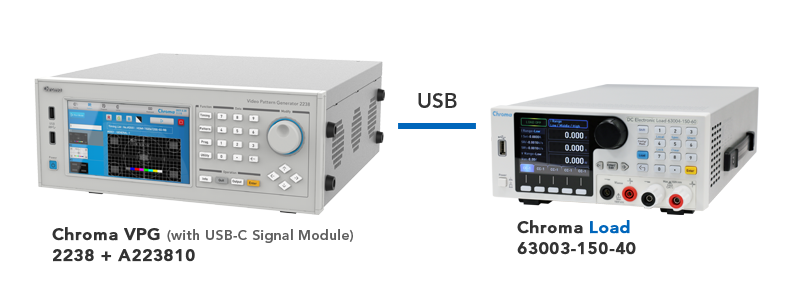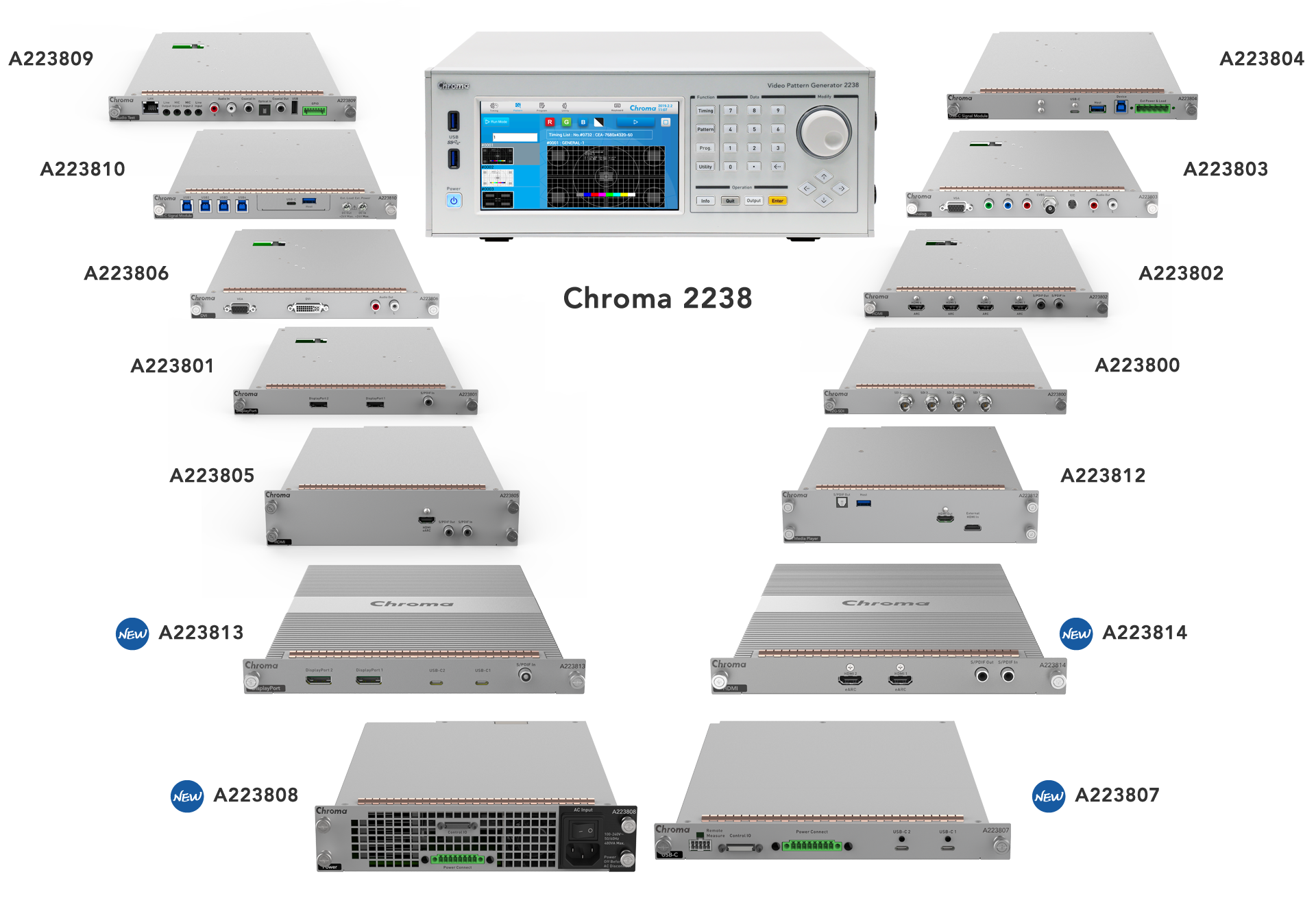
The Video Electronics Standards Association of America (VESA) officially supports DisplayPort Alternate Mode (Alt Mode) transmission through the USB Type-C standard, which allows for full audio and video output capability using the USB Type-C interface. The A223810 USB-C signal module supports DisplayPort 1.4 Alt Mode video output with a maximum single-port output resolution of 8Kx4K@30Hz, meeting the needs of cutting-edge high-spec 8K UHD (Ultra High Definition) image testing.
Chroma A223810 features a built-in high-speed graphics engine that supports HBR3 transmission rates using up to 4 lanes in compliance with the DisplayPort 1.4 specification. Users can set different lane rates to 1.62, 2.7, 5.4 or 8.1Gbps according to different resolutions. This makes for a 50% increase in total bandwidth compared to HBR2 supported in the DP 1.2a specification, resulting in a much more efficient transmission.
MST (Multi-Stream Transport) allows multiple displays to be connected to a single DP port, greatly simplifying the wiring configuration. The A223810 supports MST transmission specifications for simultaneous multi-screen output (4 Stream max or 8K 30Hz) up to 8.1Gbps.
Chroma A223810 supports USB-C Power Delivery 3.0 (PD 3.0) with up to 100W (20V/5A) power output and up to 7 configurable outputs. The programmable power supply (PPS) function enables users to set the voltage range anywhere between 5V and 20V in increments as small as 20 mV, allowing for precise adjustment of voltage and current. (paired with Chroma DC Power Supply 62015L-60-6)

The Power Delivery (PD) protocol enables automatic reading of the role of the DUT, and the automatic/manual Power and Data Role Swap function allows users to conveniently confirm the role status, suitable for a variety of USB-C power products.
The Power Role monitoring function (Source/Sink) can automatically read the power role of the device under test through PD and carry out automatic/manual Power Role Swapping, helping users to confirm the power source or power sink role of the DUT.
When the A223810 is used as a Power Sink when testing, it can read the PDO (Power Data Object) of the DUT (as a Power Source) through the PD protocol, supporting up to 7 modes. In automatic mode, the most suitable PDO can be selected automatically according to the PDO profile setup; in manual mode, the PDO parameters to be selected can be switched manually for testing.
When used as a Power Source, four types of settings are supported: Fixed, Battery, Variable, and PPS. In Fixed mode, the parameters of the maximum current and percentage of peak current can be set; in Battery mode, the parameters of maximum wattage and upper and lower voltage limits can be set; in Variable and PPS mode, parameters of maximum current and upper and lower voltage limits can be set. In this way, the module enables a comprehensive functional verification of the DUT.
USB-C cables contain a VBUS wire for power transmission. The A223810 is equipped with switching control for VBUS voltage and current detection, enabling the user to monitor the DUT's voltage and current loss.
The Data Role Swap function can swap and display the Data Role as UFP (Upstream Facing Port) or DFP (Downstream Facing Port) mode in real time.
Chroma A223810 is equipped with a Sink test function. The user can input the pull current value (according to the maximum current value of the PDO), manually switch between voltage and current test through the PDO Index, and display its verification result, which enables R&D and QA units to conveniently confirm the PDO power supply capacity of the DUT.(can be paired with Chroma DC Load 63003-150-40, 630004-150-60, and 6312A/63101A/A631003)

The A223810 USB-C supports the USB 3.2 Gen 2x1 specification, 10Gbps / 5Gbps / 480Mbps transfer speeds, as well as reading of USB version data and USB read/write file transfer rate data.
The built-in USB Pass-Through test function with USB Simulator (USB 3.0 / USB 2.0) can simultaneously perform voltage/power measurements of up to 4 USB-A units on the DUT, read USB version data, and support 5Gbps/ 480Mbps read/write file transfer rates.
Fast Role Swap (FRS) effectively ensures that devices requiring power are always powered and are not affected by other devices in the vicinity. The A223810 supports FRS through the USB-C hub, and displays the results on the screen in real time so that users can confirm whether the FRS function of the DUT is working as it should.
Chroma A223810 provides voltage and power measurement of the Configuration Channel (CC) and VCONN pins. During the automatic test, users can set the upper and lower voltage judgment range of CC and VCONN to check whether their is functioning normally.
By configuring DP Alt mode, users can set the Timing, Pattern, and Audio that they want to test and check whether the display function of the DUT is performing normally.
In the past, USB-A/B connectors were divided into positive and negative sides, and could only be inserted into the interface in one specific way. The introduction of the reversible USB-C connector solved this inconvenience. The A223810's built-in automated software can determine the USB-C connector's orientation based on the circuit, and its Cable Flip function can virtually switch between the positive and negative side. Physically plugging and unplugging the cable is no longer necessary, which saves test time and prevents damage to the connector.
The USB-C cable information reading (E-Mark) function reads cable power transmission capability, data transmission capability, and ID information, providing users with the ability to quickly confirm the status of the DUT during the testing process for USB-C interface test applications.
HDCP (High-Bandwidth Digital Content Protection) prevents illegal copying of data as it is transmitted through the interface. A223810 supports HDCP versions 1.3, 2.2 and 2.3 and allows the user to freely switch between the three versions. During the testing process, results can be output directly on the screen of the DUT, enabling users to instantly view related HDCP handshaking information.
Chroma A223810 supports a variety of gamut outputs. In addition to the basic gamut space, it also supports Wide Color Gamut color space, including RGB, ITU-R BT.601, ITU-R BT.709, ITU-R BT.2020, and DCI-P3. YCbCr 4:4:4, 4:2:2 pixel encoding and 6 / 8 / 10 / 12 bits color depth can all be set up to provide a wider color range and achieve true natural color and high-resolution images, in line with today's high-specification 8K image testing needs.
DPCD (DisplayPort Configuration Data) acts as the main communication channel between the source and sink of the DisplayPort interface. By reading the DPCD register of the sink device, Chroma A223810 can display the transmission channel and rate supported by the sink device, and carry out related tests by outputting the corresponding standard signal.
Chroma A223810 supports VESA DSC (Display Stream Compression) version 1.2a with a maximum compression ratio of 3:1. The DSC function allows users to transmit a larger amount of data using the same bandwidth. When the DSC function is not used, the DP 1.2a specification supports pixel encoding image output to a maximum resolution of 8K@30Hz. When the DSC function is used, the resolution and color depth can be raised to 8K@60Hz and 4:4:4 or 4:2:2 respectively.

The A223810 can be set to auto, manual or fast mode via Training mode, supports adjustment of the Lane Count and Bit Rate, and simulates output offsets beyond the standard signal to enable testing of the DUT's peak values.
- Lane Count: 1 / 2 / 4 lanes
- Bit Rate: 1.62 / 2.7 / 5.4 / 8.1 G
The VPG Master software enables compression of images into the DSC format. A pre-installed library of 37 images is included, and the module supports storage of up to 100 custom test pattern files (bmp, jpg, tiff). The software supports editing of image resolution, refresh rate, color space and compression rate, horizontal and vertical cutting, as well as other functions. Users can mark the image with custom text strings of up to 31 characters with editable font, size, color and position, and load it directly to the Chroma 2238 device, enabling fast determination of the DSC's on/off state. (Optional)
EDID (Extended Display Identification Data) is a VESA-defined data standard for identifying DDC displays. The A223810 uses I2C to directly read, compare and write to the EDID register inside the display, which includes the supplier's information, image size, color setting, and frequency range. At the same time, users can edit the EDID through an external PC's software interface and display the complete analysis results.

The built-in programming function can be used to set up any combination of Timing, Pattern, and Audio required by the DUT. Up to 2000 timing patterns and 5000 images can be stored, and users can add their own test patterns to meet a great variety of testing needs.
The built-in resolution test chart can accurately indicate the correct scale according to different Timings. In addition to geometric shapes and aspect ratio tests (4:3, 16:9), other test patterns such as Color Bar and Grayscale are also included. With these test patterns, users can easily determine the display's imaging quality and simultaneously monitor the HDCP and EDID execution status on the on-screen display, especially useful for R&D, production and QA purposes.
USB-C and Host ports may cause damage to the protection components and connectors during testing due to DUT failure or repeated plugging and unplugging. The A223810 is designed with independent protection components that can be extracted easily for faster and less costly maintenance.
The A223810 is a reliable and impartial signal module that delivers best-in-class image quality inspections and stringent signal integrity tests.
High conductivity beryllium copper improves the conductivity between components and reduces electromagnetic radiation leakage interfering with the DUT, in compliance with CE/EMC (Electromagnetic Compatibility) standards.
Applications: displays, smartphones, notebooks, IC design, USB Type-C cables, power banks, digital set-top boxes, adapters, EMS.
 Display
Display Phone/Notebook
Phone/Notebook IC Design
IC Design USB Type-C cable
USB Type-C cable
 Power Bank
Power Bank Set Top Box
Set Top Box Adapter
Adapter EMS Factory
EMS Factory
Video Pattern Generator 2238
USB-C Module Specifications
| Model |
A223804 |
A223810 |
| DisplayPort |
DisplayPort 1.3 |
DisplayPort 1.4 |
| Port(s) |
• USB-A x1
• USB-B x1
• USB-C x1
• Extension Power & Load x1 |
• USB-A x1
• USB-B x4
• USB-C x1
• Extension Load x1
• Extension Power x1 |
| Resolution (Max) |
4K@60Hz |
8K@30Hz |
| Lane Rate |
1.62 / 2.7 / 5.4 Gbps |
1.62 / 2.7 / 5.4 / 8.1 Gbps |
| Color Space |
RGB |
• RGB
• ITU-R BT.601
• ITU-R BT.709
• ITU-R BT.2020
• DCI-P3 |
| HDCP |
v2.2 / v1.3 |
v2.3 / v2.2 / v1.3 |
| Power Delivery |
Power Delivery 2.0 |
Power Delivery 2.0 / Power Delivery 3.0 |
| USB-C |
• USB 3.1 Gen 1
• 5Gbps / 480Mbps |
• USB 3.2 Gen 2 x1
• 10Gbps / 5Gbps / 480Mbps |
| MST |
- |
● |
| PPS |
- |
● |
| Cable Flip |
● |
● |
| FRS |
- |
● |
| DSC |
- |
● |
| HDR |
- |
● |
| Scrolling |
- |
Speed by Pixel or Line |
| USB Simulator |
- |
● |
| Configuration Channel (CC) |
● |
● |
| VCONN |
● |
● |
| Power Role |
Source / Sink / DRP |
Source / Sink / DRP |
| Data Role |
DFP / UFP / DRP |
DFP / UFP / DRP |
| PDO |
5V / 9V / 12V / 15V / 20V |
5V~20V (Programmable) |
Full Line of Chroma 2238 Signal Modules
